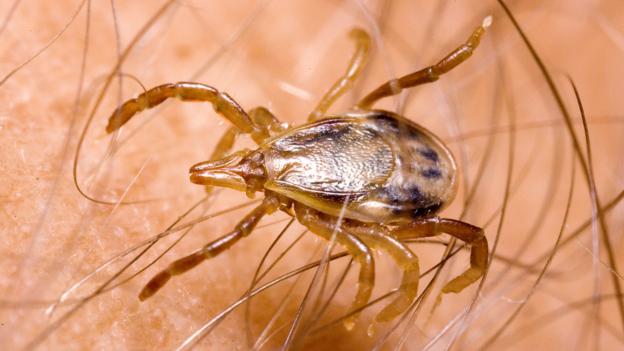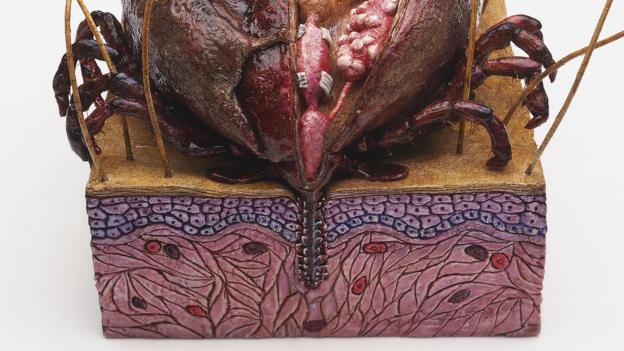The relevance of tick bites to the production of dangerous and rare allergy to red meat
2 March, 2016
A tick bite that makes you allergic to red meat. By Bianca Nogrady. bbc.news. February 05, 2016.Normally, humans aren’t affected by a bite from Ixodes holocyclus – better known as the paralysis tick. But in some cases, it can trigger a dangerous and rare allergy to red meat.Walking through Sydney’s northern beaches in the height of summer, the dense, humid bush is alive with the buzz of cicadas, the screech of rosellas, and the mouth-watering smell of barbecue.But hiding in the undergrowth is a tiny creature that is forcing some unrepentant carnivores to turn their back on sausages, steaks and meat pies.

It sounds like a fate worse than death for a meat-loving Australian. But worse is the extreme allergic reaction known as anaphylaxis which can constrict airways, drop your blood pressure through your boots, and kill you.Thanks to the common paralysis tick, also known as Ixodes holocyclus, more than 800 people around Sydney’s northern beaches have developed a dangerous and otherwise extremely rare allergy to mammalian meat.
 .An allergy to red meat would spell bad news for any barbecue-loving Sydneysider (Credit: Getty Images)
.An allergy to red meat would spell bad news for any barbecue-loving Sydneysider (Credit: Getty Images) The paralysis tick earned its name and reputation because of the often-fatal effect its bite has on domestic pets. Most humans don’t suffer any particular ill-effects from an Ixodes holocyclus bite. But in some people, the combination of tick proteins and a mammalian protein, injected in the tick’s saliva as it bites for a blood meal, are enough to trigger a potentially life-threatening allergy.Similar cases are also turning up along Australia’s east coast, in parts of the United States and in Europe, but Sydney has the dubious honour of being the hottest of hot-spots for this strange allergy. A bite from Ixodes holocyclus, better known as the paralysis tick, can trigger a life-threatening allergy given certain conditions (Credit: Science Photo Library)The tale of Ixodes holocyclus and mammalian meat allergy plays out like a great scientific detective story. Even the main actor – Sydney allergy specialist Sheryl van Nunen – says it reads like a movie script.
A bite from Ixodes holocyclus, better known as the paralysis tick, can trigger a life-threatening allergy given certain conditions (Credit: Science Photo Library)The tale of Ixodes holocyclus and mammalian meat allergy plays out like a great scientific detective story. Even the main actor – Sydney allergy specialist Sheryl van Nunen – says it reads like a movie script.
 A bite from Ixodes holocyclus, better known as the paralysis tick, can trigger a life-threatening allergy given certain conditions (Credit: Science Photo Library)The tale of Ixodes holocyclus and mammalian meat allergy plays out like a great scientific detective story. Even the main actor – Sydney allergy specialist Sheryl van Nunen – says it reads like a movie script.
A bite from Ixodes holocyclus, better known as the paralysis tick, can trigger a life-threatening allergy given certain conditions (Credit: Science Photo Library)The tale of Ixodes holocyclus and mammalian meat allergy plays out like a great scientific detective story. Even the main actor – Sydney allergy specialist Sheryl van Nunen – says it reads like a movie script. Van Nunen came across her first patient with this particular meat allergy more than two decades ago. It was an isolated case and wasn’t noteworthy other than the fact the allergy itself was unusual – mammalian meat allergy is otherwise extremely rare.Then in the early 2000s, a few more cases of people having allergic reactions to red meat began trickling into van Nunen’s clinic in Sydney’s Royal North Shore Hospital, all with the same story.“They’ve had a meal then woken up in the early hours of the morning and had a terrible anaphylaxis, or had an anaphylactic reaction half an hour after eating a meal and they can’t quite work out what it was,” she says. Whether the dinner was beef, lamb, kangaroo, venison or even buffalo, the story was the same.As any allergy specialist would, she took a detailed history, and one thing kept popping up: all these people had, at one time or another, had a large, local reaction to a tick bite. While most people might have a small itchy red bump at the location of a tick bite, these people had a large area of hardened swelling around 10-15cm in diameter, surrounded by an even larger red rash.
 A concentration of patients from Sydney’s northern beaches led van Nunen to make her discovery (Credit: Alamy)
A concentration of patients from Sydney’s northern beaches led van Nunen to make her discovery (Credit: Alamy)Then in the ensuing few years came what van Nunen describes as a deluge of cases from Sydney’s northern beaches, all reporting allergic reactions such as hives and gastrointestinal upset after a meal of red meat. And in each case, it was the same story; each patient had also, at some stage in their life, had a big reaction to a bite from Ixodes holocyclus.“It’s come to the stage now that if you come from Beacon Hill or north, particularly if you come from the peninsula, and you have an anaphylaxis and you don’t understand why that occurred necessarily … then my first question of you will be ‘what happens when you’re bitten by a tick?’”But not everyone who gets bitten by a tick develops mammalian meat allergy. So what’s going on?Ticks are notorious for their ability to trigger life-threatening allergic reactions to proteins found in their saliva. Australia has a particularly high concentration of individuals with serious allergies to tick bite itself, which may be partly due to the especially elongated mouthparts of Ixodes holocyclus. But this meat allergy was something different.At first, van Nunen wondered whether there might be something in the tick’s saliva from its previous host; perhaps a bit of protein from an animal like a bandicoot that the human immune system associates with the immunoreactive tick protein, and therefore reacts to equally.In the end, the answer came from the other side of the world.A group of US doctors had also been seeing an unexplained surge in severe allergic reactions to a drug used to treat colorectal cancer. As they reported in 2007, nearly one in four patients in Tennessee and North Carolina treated with cancer drug Cetuximab developed a severe reaction, compared to less than one in 100 elsewhere in the country.After lengthy investigation, researchers found the culprit; galactose-alpha-1,3-galactose, or alpha-gal. This carbohydrate is present in all mammals except primates, which therefore also excludes humans. Because Cetuximab is developed using a mouse cell line, it also contains alpha-gal, and that was what patients were reacting to.When the US researchers learned about the Australian tick bite-related mammalian meat allergy, another piece of the puzzle fell into place. These regions of the US have their own culprit – Amblyomma americanum, or the lone star tick. The geographic distribution of this tick neatly matches the distribution of the Cetuximab reactions.
 American researchers found the lone star tick triggers a similar allergy to red meat caused by the Australian paralysis tick (Credit: Science Photo Library)
American researchers found the lone star tick triggers a similar allergy to red meat caused by the Australian paralysis tick (Credit: Science Photo Library)What makes this story so fascinating is it’s the only situation in which we can trace the trigger for development of an allergy. We have no idea why a person develops an allergy to cats or peanuts or egg. All we know is that at some point, some combination of factors has triggered their immune system into reacting against these otherwise benign allergens.But with tick-related mammalian meat allergy, it’s very clear.“It’s the complete package,” van Nunen says. “We’ve got the provoking factor – something that changes the immune system – which is the tick.”The next question for researchers is to work out why this can happen in people who are only bitten once, while others who experience a lifetime of tick bites get away without allergy.It’s not all bad news, especially for meat lovers who live in or travel to tick-endemic areas. Tick allergy and mammalian meat allergy are preventable. Part of van Nunen’s work in recent years has been developing educational materials which help educate people on how to safely remove ticks so as to minimise the chance of an allergic reaction happening.
 When the tick is squeezed, it injects more of its saliva and stomach contents into the bite – so they are best removed by freezing (Credit: Science Photo Library)
When the tick is squeezed, it injects more of its saliva and stomach contents into the bite – so they are best removed by freezing (Credit: Science Photo Library)Their mantra is “freeze it, don’t squeeze it”. When the tick is squeezed, either by tweezers, or when it is scratched out, it injects more of its saliva and stomach contents into the bite, increasing the chance of a reaction. Instead, experts recommend using an ether-containing spray, like those used to treat warts, which can be purchased from a chemist. Freeze the tick, which kills it instantly, and it will drop off harmlessly.Van Nunen also takes a preventive approach whenever she ventures to the northern beaches. A self-described ‘committed carnivore’, she’s not taking any chances, wearing insect-repellent clothing and spraying herself with insect spray.But she also has a grudging admiration for the female tick, who is the one responsible for such gastrointestinal misery.“I think about the tick as another mother,” van Nunen says. “Here’s a living little creature, she’s trying to do a great job raising a family and protecting them from the elements and making sure they find their way in life, and she just happens to have this really nasty side effect [for] humans.”Join 500,000+ Future fans by liking us on Facebook, or follow us on Twitter, Google+, LinkedIn and Instagram.If you liked this story, sign up for the weekly bbc.com features newsletter, called “If You Only Read 6 Things This Week”. A handpicked selection of stories from BBC Future, Earth, Culture, Capital, Travel and Autos, delivered to your inbox every Friday.

